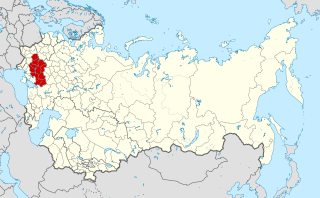Related Research Articles
The 1st Red Banner Army was a Red Army field army of World War II that served in the Soviet Far East.
The 4th Army was a Soviet field army of World War II that served on the Eastern front of World War II and in the Caucasus during the Cold War. It was disbanded after the fall of the Soviet Union, with its divisions being withdrawn to Russia and disbanded.

The Leningrad Military District was a military district of the Armed Forces of the Russian Federation. In 2010 it was merged with the Moscow Military District, the Northern Fleet and the Baltic Fleet to form the new Western Military District. In December 2022, Defense Minister Sergey Shoigu proposed to reestablish it along with the Moscow Military District, a decision confirmed in June 2023 by Deputy Chief of the General Staff Yevgeny Burdinsky. On December 17, 2023 Vladimir Putin announced plans to recreate the Leningrad Military District as a reaction to Finland joining NATO.
A rifle corps was a Soviet corps-level military formation during the mid-twentieth century. Rifle corps were made up of a varying number of rifle divisions, although the allocation of three rifle divisions to a rifle corps was common during the latter part of World War II.

The Kiev Military District was a military district of the Imperial Russian Army and subsequently of the Red Army and Soviet Armed Forces. It was first formed in 1862, and was headquartered in Kiev (Kyiv) for most of its existence.
The 7th Rifle Division was an infantry division of the Soviet Union's Red Army, formed twice.

The 10th Army of the Soviet Union's Red Army was a field army active from 1939 to 1944.
The 23rd Army was a Field Army of the Soviet Union's Red Army.
The 8th Rifle Division was a military formation of the Soviet Union's Red Army in the Winter War, the Soviet invasion of Poland, and World War II. It was formed three times.
The 10th Rifle Division was a military formation of the Red Army. It existed by 1920, but was formally created on 20 June 1922, based on the 29th Infantry Brigade. It was then recreated at Vladimir in September 1939, and fought in the Second World War.
The 11th Rifle Division was a military formation of the Soviet Union's Red Army. Its personnel were involved in the protection of the demarcation line in Pskov, defensive battles against the Army of the Southern Front in Krasnov Novohopersk - Borisoglebsk, against the army and the forces of Estonia, Bulak Balakhovich in Marienburg in defense of Petrograd and as the offensive against Yudenich's troops in Pskov the Luga-Gdov, Yamburg, Narva, Dvina-Rezhitsk directions, the Polish-Soviet war of 1920, in the suppression of the Kronstadt uprising participated in the Soviet-Finnish War and World War II.
The 86th Rifle Division was an infantry division of the Soviet Union's Red Army during the interwar period, World War II, and the early postwar period, formed twice.
The 102nd Rifle Division was an infantry division of the Red Army which participated in the Second World War. It was formed three times. Its first formation was listed as part of the active army from 2 July to 19 September 1941. Its third formation was awarded the Order of Lenin, the Order of the Red Banner, and the Order of Suvorov, 2nd class.
The 29th Rifle Division was an infantry division of the Red Army and later the Soviet Army.
The 33rd Rifle Division was a rifle division of the Red Army and Soviet Army, formed twice. The division was formed in 1922 at Samara and moved to Belarus in the next year. It fought in the Soviet invasion of Poland in September 1939 and in the Occupation of Lithuania in June 1940. After Operation Barbarossa, the division fought in the Baltic Operation and Leningrad Strategic Defensive. In January 1942, it fought in the Toropets–Kholm Offensive. The division participated in the Leningrad–Novgorod Offensive, the Pskov-Ostrov Offensive, the Tartu Offensive and the Riga Offensive. In 1945, the division fought in the East Pomeranian Offensive and the Battle of Berlin. The division remained in Germany postwar with the Soviet occupation forces and disbanded in 1947. In 1955, it was reformed from the 215th Rifle Division in the Far East and inherited that division's honorifics, but was disbanded in 1956.
The 7th Rifle Corps was a corps in Red Army and Soviet Armed Forces, before and during The Great Patriotic War/World War II.
The 11th Rifle Corps was a corps of the Red Army, formed twice.
The 15th Rifle Corps was a rifle corps of the Red Army, formed five times; each formation was a distinct unit unrelated to the others. It was part of the 5th Army. It took part in the Soviet invasion of Poland in 1939.
The 265th Motor Rifle Division was a motorized infantry division of the Soviet Army during the Cold War.
References
- Feskov, V.I.; Golikov, V.I.; Kalashnikov, K.A.; Slugin, S.A. (2013). Вооруженные силы СССР после Второй Мировой войны: от Красной Армии к Советской [The Armed Forces of the USSR after World War II: From the Red Army to the Soviet: Part 1 Land Forces] (in Russian). Tomsk: Scientific and Technical Literature Publishing. ISBN 9785895035306.